Did you ever think a violin could be made from nails?
Did you ever think a violin could be made from nails?
 The nail violin is in a class of instruments called idiophones. Idiophones are musical instruments that are made from various materials that have their own innate sound characteristics such as metal, glass, ceramics, etc. bells, castanets, cymbals, glockenspiels, systerns, gongs, rattles, xylophones, and, the nail violin are all examples of idiophones.
The nail violin is in a class of instruments called idiophones. Idiophones are musical instruments that are made from various materials that have their own innate sound characteristics such as metal, glass, ceramics, etc. bells, castanets, cymbals, glockenspiels, systerns, gongs, rattles, xylophones, and, the nail violin are all examples of idiophones.
 The nail violin is in a subset of idiophones called friction idiophones, and was invented by a German violinist named Johann Wilde in 1740. As the story goes he accidentally drew his violin bow over a metal rod and noticed that it produced a resonant sound. Later in the 18th century other friction idiophones were invented by another German, Ernst Chladni, who experimented with the transmission of vibrations. The nail violin consists of a wooden sound box with metal nails or rods of various lengths which are tuned to a chromatic scale. As well as being bowed it can be played in various ways including striking, plucking or rubbing the nails or rods .
The nail violin is in a subset of idiophones called friction idiophones, and was invented by a German violinist named Johann Wilde in 1740. As the story goes he accidentally drew his violin bow over a metal rod and noticed that it produced a resonant sound. Later in the 18th century other friction idiophones were invented by another German, Ernst Chladni, who experimented with the transmission of vibrations. The nail violin consists of a wooden sound box with metal nails or rods of various lengths which are tuned to a chromatic scale. As well as being bowed it can be played in various ways including striking, plucking or rubbing the nails or rods .
 The only known virtuoso of the nail violin was a Bohemian musician named Senal. He modified the instrument by adding sympathetic strings and called it the “violino harmonico,” and performed throughout Germany in the late 1700s.
The only known virtuoso of the nail violin was a Bohemian musician named Senal. He modified the instrument by adding sympathetic strings and called it the “violino harmonico,” and performed throughout Germany in the late 1700s.
The modern waterphone, invented by Richard Waters is an adaptation of the nail violin that uses water in its resonator to create complex sounds, but is played atonally rather than chromatically like the nail violin.
How to make a nail violin
See also: Daxaphone
